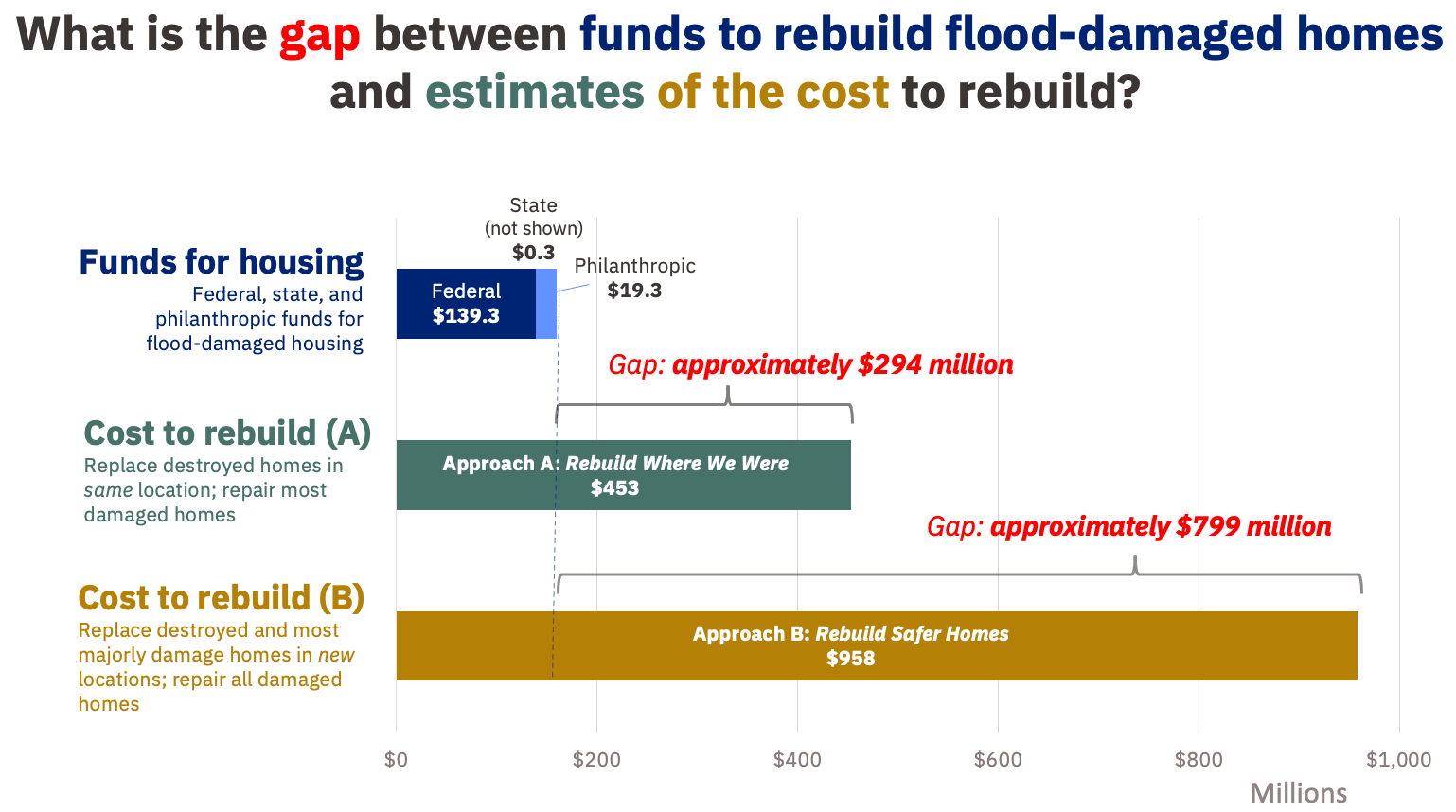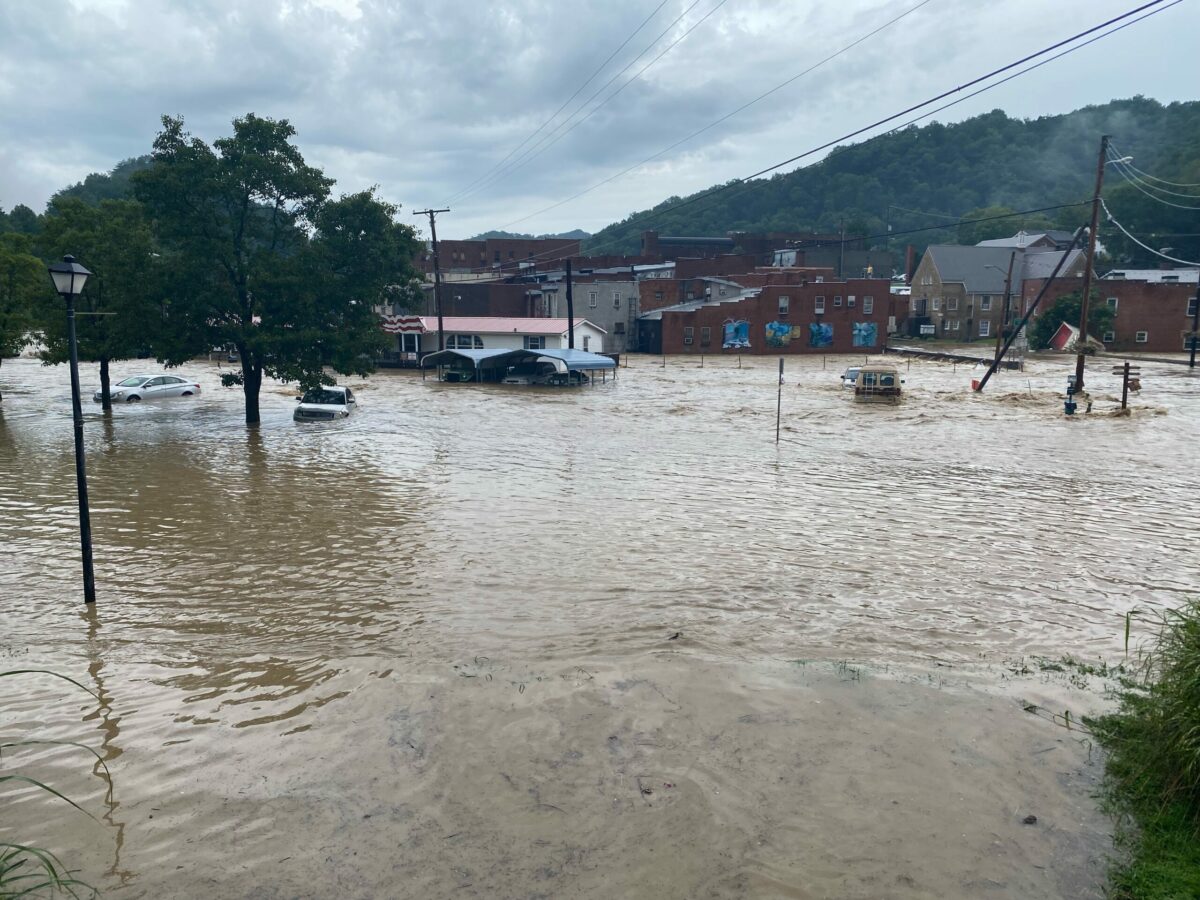In a new report from the Ohio River Valley Institute and Appalachian Citizens’ Law Center, we estimate it will cost $450 to 950 million to rebuild homes affected by the flood, depending on how many homes are relocated to less flood-prone areas. Our report finds that 8,950 homes were damaged in the flood – 542 homes were destroyed and more than 4,500 homes sustained major damage.
Local governments have few resources to rebuild, and many families with damaged homes are among those with the least ability to pay for repairs in all of Kentucky. Below we investigate federal, state, and philanthropic funds allocated specifically to housing recovery after the flood and find that only $159 million in funds have been allocated or raised to date. This investment is just 17 – 35% of what is needed to rebuild homes in southeastern Kentucky. In spite of an unprecedented $2.7 billion available in Kentucky’s rainy day fund, thus far philanthropic sources have invested more in helping families rebuild than the state of Kentucky. It is critical that the legislators take action to help address the huge gap in funding needed to rebuild housing after the flood.

The Disaster: July 2022 Flooding in Southeastern Kentucky
In late July, 14-16 inches of rain fell in southeastern Kentucky over a five day period, mostly falling the night of July 27th and the morning of the 28th at rates of over 4 inches per hour. It flooded in the early morning hours. It flooded areas and homes that have never flooded before, many outside of designated flood zones [1]. A 20-county-wide area was affected by the devastation. For those who experienced the event, the days that followed were filled with chaos and grief. Communities grappled with how to respond to and clean up from a flooding disaster of this magnitude, learning what to do and what not to do as they worked around the clock. Over forty lives were lost, hundreds of homes were completely destroyed, thousands of homes were affected and made uninhabitable, and public infrastructure (roads, water systems, sewer systems, schools and more) was devastated. Over six months after the flood, public infrastructure remains in disrepair and there are still many families receiving formal housing assistance, living in Federal Emergency Management Authority (FEMA) travel trailers or in Kentucky State Park facilities. Many others are living in unrepaired homes or staying with friends or family.
Eastern Kentucky communities are and will continue to be put at risk by a changing climate. Extreme precipitation in the steep, rugged terrain causes flooding in the flat areas where people live. Homes that are able to evade floodwaters, even those built on higher ground, are at risk of landslides from heavy precipitation destabilizing slopes. The natural geology is prone to landslides and landslide risk is further exacerbated by decades of coal mining without reclamation. The Kentucky Geologic Survey identified over 1,000 landslides and debris flows triggered by the July event.
In spite of these risks, the region does not have the resources needed to reduce harm and mitigate damage from future extreme events. The last decade of decline in the coal mining industry has impacted public budgets and infrastructure and diminishes the capacity of local government response and mitigation. For example, in Letcher County, tax revenues declined by 40% between 2011 and 2019. Individuals and families also don’t have the resources needed to build back their homes and start again from zero. The region has persistently high poverty levels, a low median income, high disability rates, and an aging population. Federal, state, and philanthropic support for public infrastructure and for individual families is essential for recovery.
The Housing Crisis
Prior to the flood, there was already a housing crisis in southeastern Kentucky. Scott McReynolds, executive director of the Perry County-based Housing Development Alliance, estimates that at least 40% of the population was already inadequately housed in their service region, meaning homes were substandard (not a decent place to live), overcrowded, or unaffordable. In many southeastern Kentucky counties, there is a high reliance on mobile and manufactured units, homes are energy inefficient, which further exacerbates the cost of housing, and, though progress over the decades has been made, compared to the national average there are still a disproportionate number of households without adequate plumbing. Furthermore, the housing that exists is unaffordable for many. If a household spends more than 30% of their income on housing, they are considered cost-burdened. A 2018 study completed by researchers at Virginia Tech found that over 25% of families in Appalachian Kentucky spend more than 30% of their income on housing.
The flood destroyed at least 542 homes and damaged thousands more. Though the path to adequately house all of the affected families is daunting, there is also an opportunity to build back homes that are safer, energy efficient, and more affordable. Unfortunately, there are limited resources to help families achieve that outcome. Though there has been tremendous effort made by philanthropy, volunteers, and neighbors to clean out, repair, and rebuild homes, there remains tremendous need. Though not the only constraint, one of the primary barriers to addressing the housing crisis is funding.
UPDATE April 14, 2023: The table below has been updated as of April 14, 2023 to reflect new funding that has been made available since the original publication date of this blog post on February 23, 2023. Since that time, we have identified an additional $250 million in funding sources. Added to our original finding of $159 million in funding sources, there are now an estimated $409 million in funds available. The increase in resources is primarily due to the announcement of $187 million in CDBG-DR funding, new state legislation that provides $10 million to the newly created Kentucky Rural Housing Trust Fund, and additional funds in the HMGP and SBA loan program.
The table above shows approximately $159 million in funds that have been allocated to repair and replace flood damaged homes—$139.3 million from federal sources (including the National Flood Insurance Program) and $19.3 million in total funds from philanthropic sources. Included in this calculation is funding from the state’s affordable housing trust fund; however, that fund serves all of Kentucky and is not targeted assistance for this disaster. The state has provided no additional funds for housing assistance.
The Funding Gap
We at the Ohio River Valley Institute and Appalachian Citizens’ Law Center used FEMA data to calculate the number of homes damaged by the flooding and estimated the cost to repair and replace affected homes. Our report finds that 8,950 homes were damaged in the floods—542 homes were destroyed and over 4,500 homes sustained major damage. Our findings are greater than estimates that have been released by other organizations. For example, the Red Cross reported that approximately 4,000 homes were damaged. We believe our calculation is greater because the Red Cross assesses damage based on a visual assessment from outside the home, and does not capture any homes that were inaccessible by road or not visible from the road. After the flood, over 150 bridges were in disrepair and contributed to inaccessibility.
We estimate that it will cost between $450 and $950 million to repair and replace all of the affected homes. The lower end of that calculation accounts for repairing and replacing homes in the same location. The higher estimate accounts for replacing and relocating destroyed homes and the majority of homes that sustained major damage. It is evident that the $159 million in funds dedicated to homeowners thus far does not come close to meeting the need. Federal, state, and philanthropic funds will cover just 17-35% of what is needed to rebuild homes in southeastern Kentucky.
Federal funding programs can be slow to disburse money to the state. While additional federal funding will probably come, it is unlikely to be enough to rebuild damaged housing. There will likely be additional funds granted to Kentucky through the Hazard Mitigation Grant Program (HMGP). The maximum HMGP award total is capped at 20% of the amount that FEMA spends on public and individual assistance for the disaster. Because Kentucky’s public assistance funding is not yet finalized, the maximum amount that Kentucky could receive through HMGP isn’t set yet either. Kentucky has submitted applications to the Flood Mitigation Assistance (FMA) and Building Resilient Infrastructure and Communities (BRIC) programs, but these funding sources are also unlikely to address the unmet need. Historically, few BRIC funds have been awarded to Kentucky. FMA funds are limited to properties with flood insurance, and the vast majority of homes damaged by the floods did not have flood insurance. Though additional funds may come through these FEMA programs, these investments must result in flood mitigation outcomes rather than simply be used to rebuild damaged homes. Therefore, these programs are complementary to funding that can be used for building new homes or repairing damaged homes as they can provide additional funding for the extra costs of mitigation, such as elevating a home, or buying someone out of a flood-prone property so that they can purchase land elsewhere.
The largest bucket of additional federal funding will likely come from the Community Development Block Grant Disaster Recovery Funds (CDBG-DR). The amount of funds available to the state through the CDBG-DR program will not be announced for several more months. However, it is unlikely that this federal funding source will be sufficient to address unmet housing needs. After the 2021 tornado and flooding disaster, Kentucky calculated unmet needs for housing, infrastructure, economic revitalization, and public services to be over $202.3 million. Unmet housing needs alone were greater than $110 million. However, the total CDBG-DR award was $74.9 million, with only $39.9 million allocated for housing. Based on this example, it is probable that there will still be unmet housing needs even after the CDBG-DR funds are allocated and exhausted.
Proposed Solutions
This is the third federally declared disaster in Kentucky in just a short, two-year time period, and it won’t be the last. It is critical that the state step in and appropriate funds to help address this housing crisis and rebuild homes and public infrastructure in a manner that mitigates harm from future disasters. Governor Beshear is leading an effort to acquire land on higher ground to rebuild homes. Though a portion of the $13.1 million in funds raised for the TEAM KY relief fund have been committed to support home development on these sites, even if the entire $13.1 million was committed it would still be a fraction of what will likely be needed to fully develop these areas.
A coalition of housing developing organizations and allies are supporting a proposal to create an Affordable Housing Emergency Action Recovery Trust Fund (AHEART) to be administered by the Kentucky Housing Corporation. The coalition has proposed a $150 million allocation this year to support housing for victims of all three federally declared disasters, but the structure of the fund is such that it can be used for future disasters as well. Similar to how the CDBG-DR funds function at a federal level, the state would appropriate funds into the Trust Fund on an annual or as-needed basis. However, no legislator has stepped up to champion this proposal. In spite of an unprecedented level of funds available in Kentucky’s rainy day fund, Senator and House leadership have indicated that they are unwilling to open up the budget. Recent reporting suggests that legislators may be open to expanding the eligible uses of the remaining $175 million in funding that was appropriated last year for flood recovery during a special session.
With the availability of additional funds cloaked in uncertainty, those building and repairing homes—homeowners, developers, and nonprofits—are investing in least cost and short-term solutions rather than empowered with the resources needed to reimagine, adapt, and build safer, more resilient communities.
[1] A map prepared for Foundation for Appalachian Kentucky mapped 5000 flood-affected homes and found many located outside of FEMA-designated flood zones.

